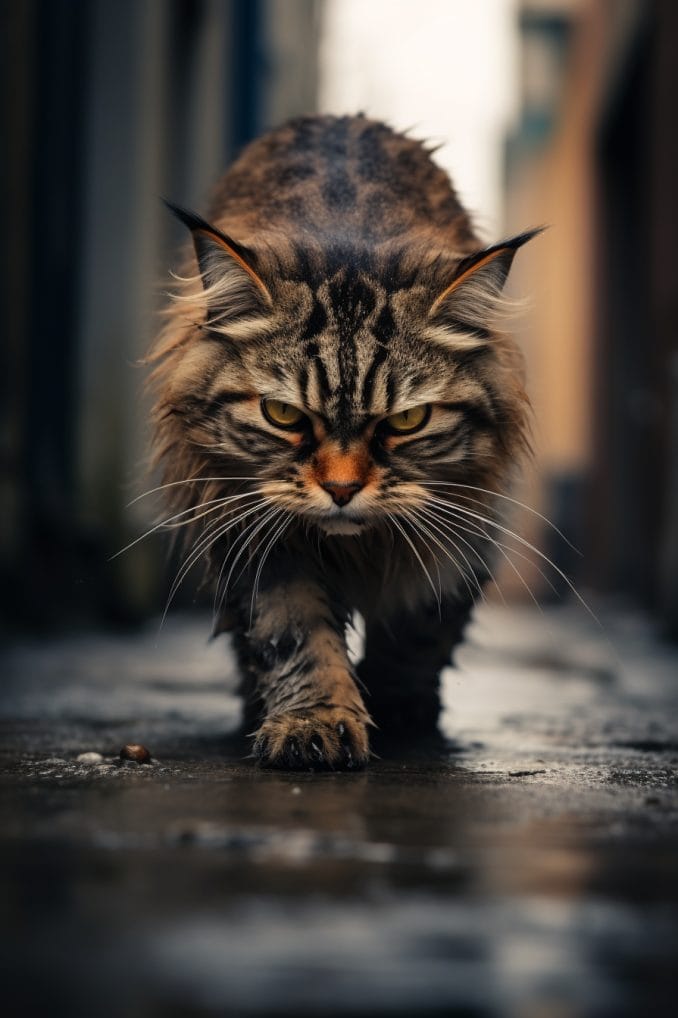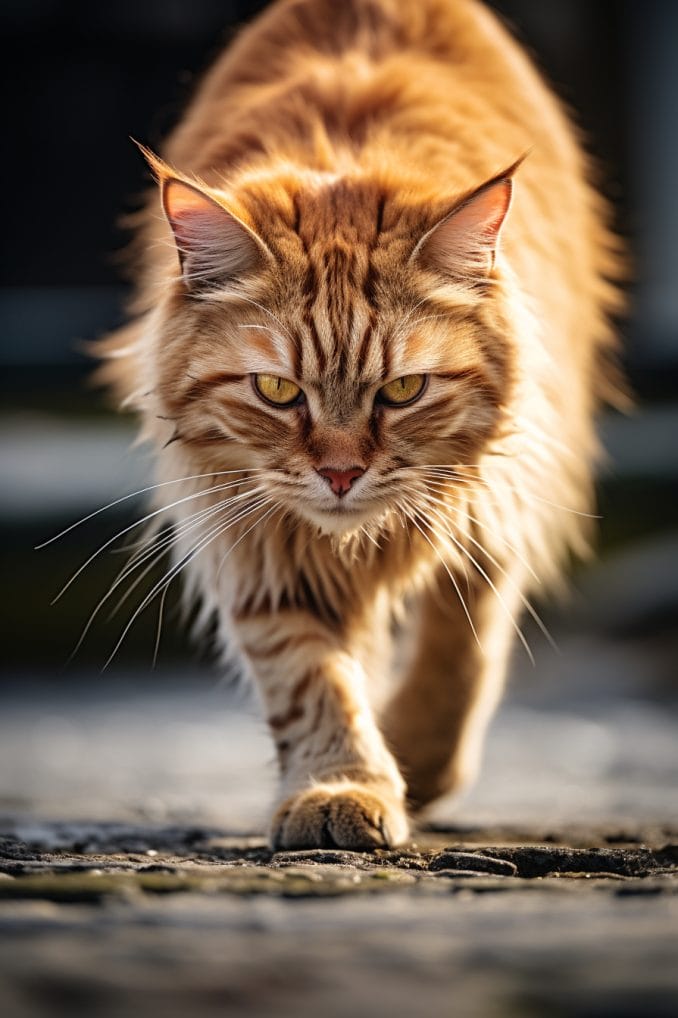
Hello, cat enthusiasts!
Have you ever pondered over the regal demeanor of your feline companion, asserting dominance in your home?
In this comprehensive guide, we embark on a fascinating exploration into the realm of dominant cat behavior.
Uncover the subtle signs, delve into the underlying causes, distinguish between various types, and, most importantly, discover effective strategies for peacefully managing and coexisting with your confidently assertive furball.
Signs of Dominant Cat Behavior
Scratching furniture
Dominant cats may use furniture as a scratching post to mark their territory.
This behavior is a clear indicator of their desire to establish and assert dominance within their living space.
Understanding this action helps in addressing territorial instincts and providing appropriate outlets for scratching, such as designated scratching posts.
Body posture
The body language of dominant cats is often characterized by confidence.
This includes a tail held high, ears forward, and a straight posture.
Observing and recognizing these confident physical cues is crucial in identifying dominant behavior, allowing for proactive measures to foster a balanced and respectful feline-human dynamic.
Aggressive play
Playful activities can escalate into aggression in dominant cats, manifesting through biting or swatting.
Such behavior serves as a means for the cat to establish and reinforce their dominance.
Recognizing the shift from playful to aggressive play enables cat owners to intervene appropriately, redirecting the behavior towards more positive interactions.
Urine marking
Spraying or marking with urine is a common sign of a cat asserting its territory.
Dominant cats may engage in urine marking to establish boundaries and communicate their presence.
Addressing this behavior involves understanding the motivations behind it and implementing strategies to minimize territorial stress, such as maintaining a clean litter box and providing sufficient vertical spaces.
Blocking access
Dominant cats may exhibit a territorial tendency to block doorways or paths to control movement within their environment.
This behavior is a manifestation of their desire to assert dominance and control access points, necessitating an understanding of their territorial instincts and providing alternative pathways to ease potential conflicts.
Mounting behavior
Another expression of dominant behavior is seen in mounting, where a cat may attempt to establish dominance through physical contact.
This behavior is not limited to interactions with other cats; dominant cats may also display mounting behavior towards people.
Recognizing this conduct enables cat owners to manage interactions appropriately, ensuring a balanced and respectful relationship.
Resource guarding
Dominant cats may engage in resource guarding, where they aggressively protect their possessions such as food, water, toys, or sleeping areas.
Understanding and addressing resource guarding is essential for maintaining a peaceful multi-cat household or fostering a secure environment for the cat and its human companions.

Root Causes of Dominant Cat Behavior
Territorial instincts
Dominant behavior often originates from cats’ inherent territorial instincts.
Cats have a natural inclination to establish and defend their space.
Dominance, in this context, serves as a means for them to secure their territory and communicate their presence to other cats and potential intruders.
Recognizing and respecting these territorial instincts is crucial for understanding and addressing dominant cat behavior.
Lack of socialization
Cats not adequately socialized during their early kittenhood may struggle with understanding social boundaries.
This lack of exposure to diverse environments, people, and other animals can contribute to dominant behavior as cats may not comprehend acceptable social norms.
Addressing this requires patient and gradual socialization efforts to help the cat navigate social interactions more confidently.
Changes in environment
Significant changes in a cat’s environment, such as moving to a new home or introducing new pets, can trigger dominant behavior.
Cats may assert dominance as a coping mechanism in response to these changes, attempting to establish control and familiarity.
Providing a gradual transition and creating safe spaces can help mitigate stress-induced dominant behavior during environmental changes.
Unneutered/unspayed cats
Hormonal changes in intact (unneutered or unspayed) cats can contribute to dominant behavior.
The presence of reproductive hormones may intensify territorial instincts and lead to more assertive behaviors.
Neutering or spaying can often help mitigate dominant behavior associated with hormonal influences, promoting a more balanced and manageable demeanor.
Types of Dominant Cat Behavior

Possessive dominance
Cats may exhibit possessive dominance, becoming overly protective or territorial about certain possessions such as toys, food, or specific areas within the home.
This behavior reflects their desire to establish control and ownership, and understanding this type of dominance is essential for promoting a harmonious living environment.
Status dominance
In a multi-cat household, cats may engage in status dominance to establish their rank within the social hierarchy.
This type of behavior is common when multiple cats coexist, and understanding the dynamics of their interactions is crucial.
Aggressive dominance
Aggression, particularly during play, can be a form of asserting dominance.
Cats may display aggressive behavior as a means to establish control or dominance over their playmates or territory.
Fear-induced dominance
Cats may exhibit dominant behavior as a response to fear, using aggression as a defense mechanism.
This type of dominance is often a result of stress or perceived threats in the environment.
Managing Dominant Cat Behavior

Provide adequate resources
Mitigate competition among cats by ensuring each feline companion has access to their own food, water, and litter box.
This simple yet crucial step minimizes territorial disputes over resources, promoting a more harmonious coexistence.
Enrichment activities
Redirect your cat’s energy positively by incorporating enrichment activities into their daily routine.
Toys, puzzles, and scratching posts stimulate their minds and provide a constructive outlet for natural behaviors, reducing the likelihood of engaging in dominant behaviors born out of boredom or excess energy.
Neutering/spaying
Consider neutering or spaying your cat to reduce hormonal influences that may contribute to dominance, especially in intact (unneutered or unspayed) cats.
This preventive measure can significantly alleviate territorial instincts and aggressive behaviors, fostering a more balanced and manageable demeanor.
Positive reinforcement
Reinforce positive interactions by rewarding good behavior with treats and affection.
Positive reinforcement encourages desirable behaviors and helps create a positive association with certain actions, making it an effective tool in managing and redirecting dominant tendencies toward more acceptable conduct.
Seek professional advice
In cases where dominance escalates into aggression or severe behavioral issues, seeking professional advice is crucial.
Consult with a veterinarian or animal behaviorist who can provide tailored insights and intervention strategies.
Professional guidance ensures a comprehensive understanding of the specific dynamics at play and facilitates the implementation of effective solutions.
Conclusion
Achieving harmony in your relationship with your feline companion requires a deep understanding and effective management of dominant cat behavior.
By keenly recognizing the subtle signs, proactively addressing underlying causes, and incorporating positive reinforcement techniques, you pave the way for a home environment where both you and your assertive kitty can thrive in comfort and contentment.
FAQs
Yes, with patience and consistent positive reinforcement, a dominant cat can learn to exhibit more submissive behaviors.
Neutering or spaying can help reduce hormonal influences that contribute to dominance, but it may not be the sole solution. Positive reinforcement and environmental enrichment are also essential.
Yes, changes in the environment, health issues, or the introduction of new pets can trigger dominant behavior even in older cats. Addressing the root cause is key to managing late-onset dominance.
- Essential Oils Safe for Cats: What Every Pet Owner Needs to Know - May 23, 2025
- Herbal Supplements for Cats: A Natural Approach to Cat Wellness - May 21, 2025
- Signs of a Healthy Cat Coat: What Every Cat Owner Should Know - May 19, 2025


GIPHY App Key not set. Please check settings